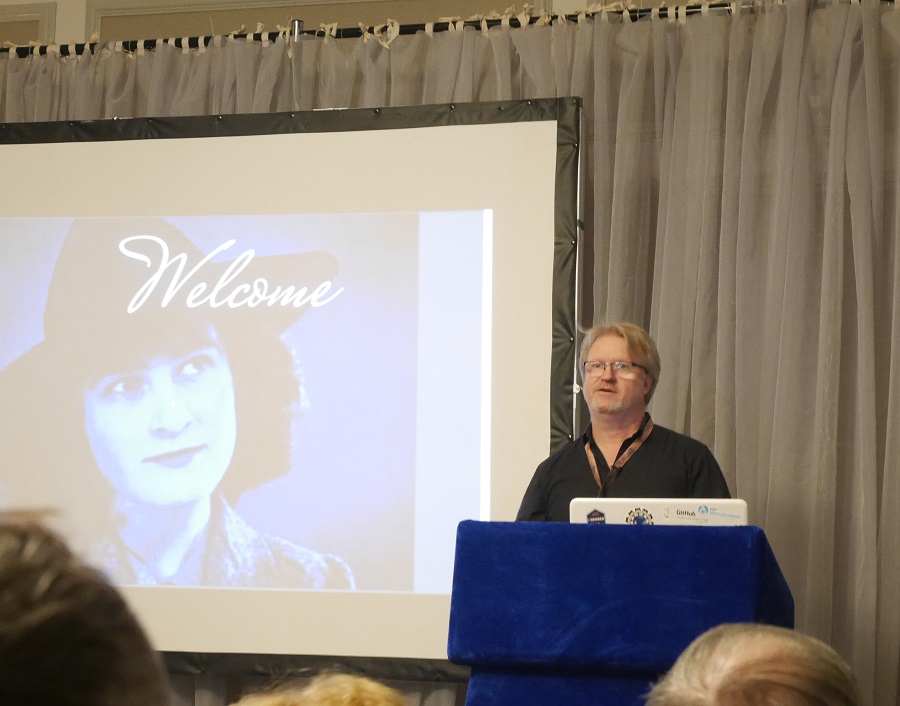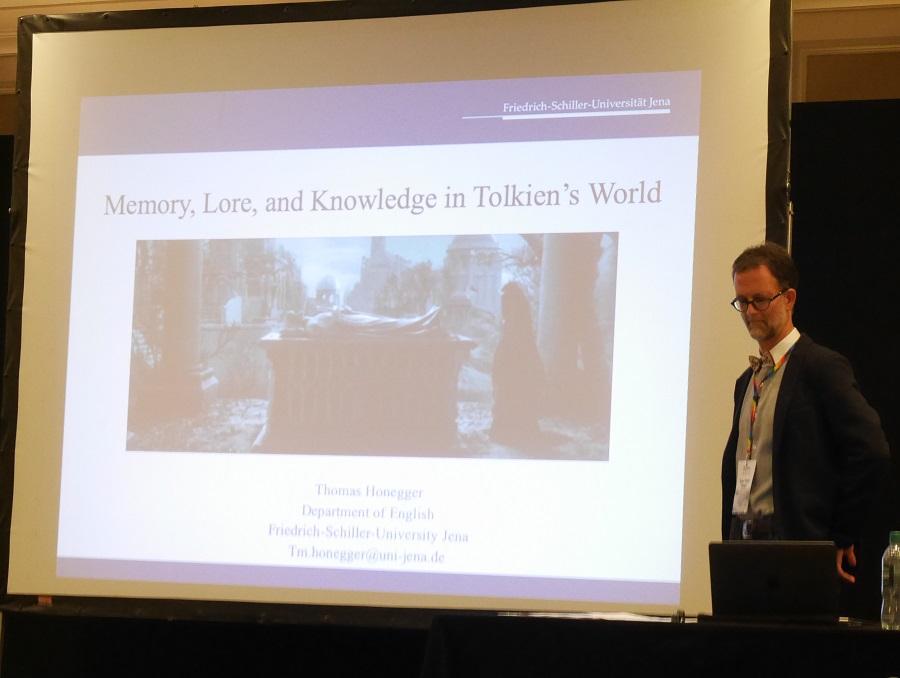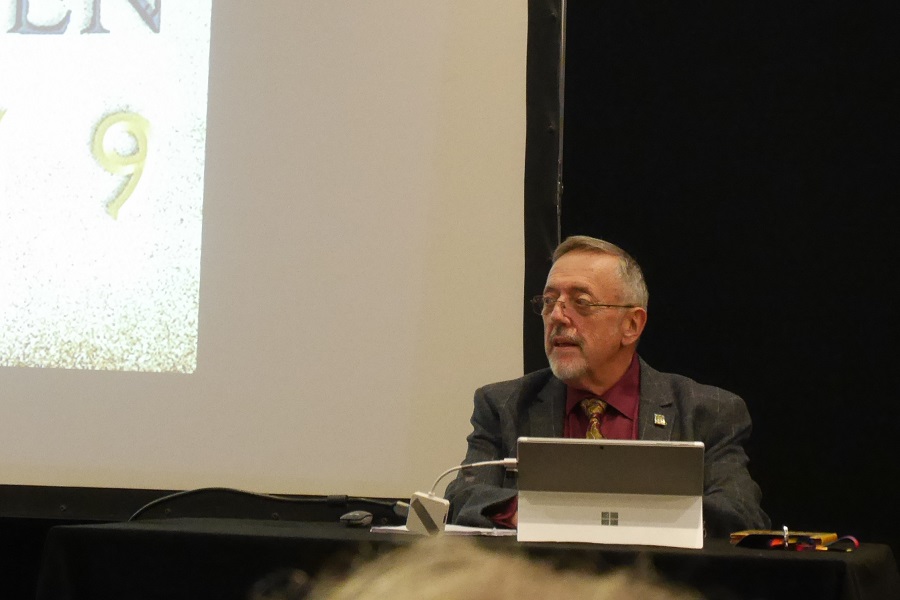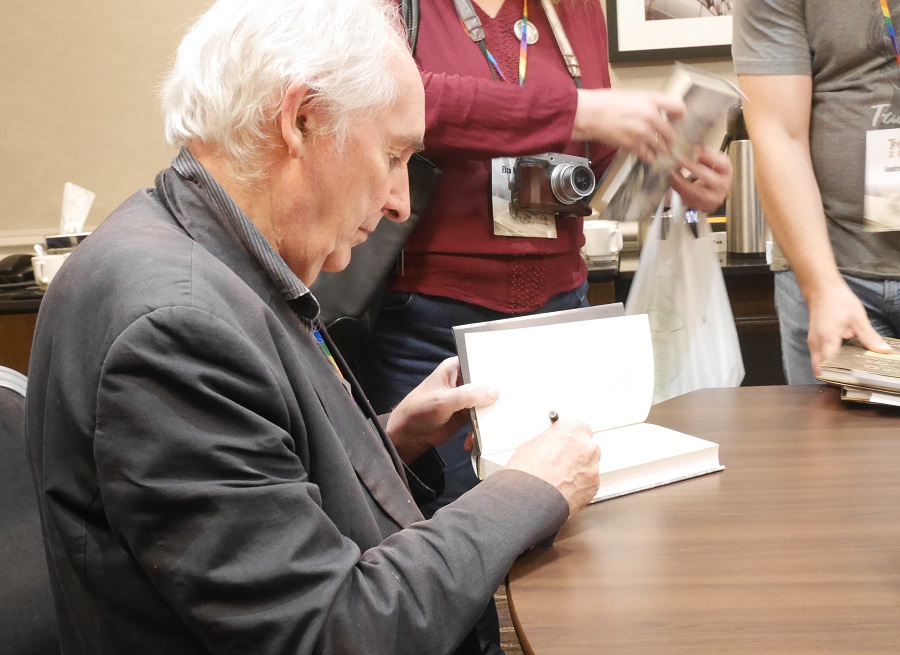From 7th – 11th of August, the Tolkien Society celebrated its 50th anniversary at the Macdonald Burlington Hotel in Birmingham. With Guests of Honour such as Tom Shippey, Alan Lee, Ted Nasmith, John Garth, and many more, it truly ended up, as prophesized by the Chair of the Society Shaun Gunner, an event to remember.
You can read part 1, covering day one and two, over here!
Day 3 – 09th August
After a night that felt rather too short for my liking, I made my way over to Burlington Hotel to attend the first three talks for the day. Jay Johnstone gave a talk about Pauline Baynes’ career and work from an artists’ perspective. Soon enough, interesting discussions over how Baynes got the job to illustrate Tolkien’s work arose. Apparently, various different versions of how she got involved circulate among those who knew her. Johnstone’s talk was, however, more than summary of Bayne’s life. Being an artist himself, Johnstone’s insights became very intriguing when he began to illustrate to the audience how Baynes’ art could reveal the her level of talent. Her capability to create detailed work tells you how confident and skilled of an artist she was. Johnstone argued that the confidence refers to the fact that she made few mistakes on a very minute scale.

Afterwards, Marie Bretagnolle presented her analysis on Illustrating The Lord of the Rings. For her talk, Bretagnolle compared and contrasted the centennial illustrated edition by Alan Lee and the Folio Society edition illustrated by Eric Fraser and Ingahild Grathmer. “Art opens a window to the text and demands the reader to stop reading”, Bretagnolle argued. After an analysis from an artists’ perspective, it was interesting to listen to an examination focusing on the symbolism of how and why certain passages were illustrated and how both illustrated editions differ. Personally, I own just the Alan Lee edition, but the Folio Society edition has been on my wish-list for a long time and once I’ll get it, I will be able to interpret the illustration very differently.
Personally, I love collecting illustrated editions of Tolkien’s work. As of now, I own six different illustrated editions of The Hobbit. One of these was the, a rather recent acquirement, Finnish translated edition illustrated by Tove Jansson. So once I saw that Sonja Virta gave a talk on The Source texts for Tove Jansson’s illustrations for The Hobbit, I knew I had to be there. I knew not much about either Tove Jansson nor about the controversy of the different translated editions in Finland of Tolkien’s The Hobbit. Virta explained and examined the history of Tove Jansson’s illustrated edition and its the relationship to its predecessor. Now, I don’t speak Finnish which means that I got the illustrated Jansson edition just for Jansson’s artwork. Thanks to Virta, I now know more about it and look at the artwork very differently.
Despite having taken notes as often as possible, I can’t remember when I went to the art show at the Medicine Bakery. It might’ve been right after my morning filled with art. The art show was not at the hotel, but at a bakery & café in order to be open to the public and promote Tolkien’s work. I never knew I needed a Tolkien-themed art café in my life, but as soon as I entered the bakery, I didn’t want to leave. Since I saw many familiar faces there, I’m sure many other Tolkien 2019 visitors felt at home as well (anyone wants to open a Tolkien-themed café with me?). The art show not only featured the work of a variety of different artists, such as Ted Nasmith or Jenny Dolfen, it also sold artwork. Needless to say, I left with two prints and a postcard collection.

Speaking of memory, after my break I went to see Thomas Honegger’s fascinating talk on Memory, Lore, and Knowledge. Our idea of the reliability of lore versus knowledge seems counter-intuitive to that of the inhabitants of Middle-earth. Apparently, Honegger argued, lore occurs far more frequently in LOTR than knowledge. Moreover, memory, manifests itself in many different ways and can easily become lore in Middle-earth.
Another look at memory followed by Brian Sibley’s talk on his Travels in Middle-earth. Nowadays Sibley is most known for his involvement in Peter Jackson’s movie adaptations, but back in the 1980s he was known as the producer of a radio dramatization of LOTR for the BBC. While I have heard and enjoyed the radio dramatization, I am far too young to know anything about the creation process so much of what Sibley talked about was new to me. For example, did you know that Brian Sibley is a member of the Tolkien Society? I didn’t.

Before the magnificent Banquet, where I talked to some very lovely people, I attended Christina Scull’s talk on the Natural Growth in Writing in LOTR. As someone who struggles to have a plan in my creative endeavors, it was very satisfying to hear that Tolkien himself knew very few certain detail about what is going to happen next and that much of it gradually developed. Almost, as if he himself was, as explained by Scull “just as desperate to find out” what happens next just as the reader. Scull went on to highlight the gradual changes LOTR underwent and how it slowly developed into what we know today.
The Banquet itself, well, what can I say about it other than that the food was good, but the company way better. Although, as a German, it was the first time for me to toast to the Queen and it was rather amusing if I’m completely honest. I’ve mentioned it before, but I’m not a huge party-goer so a structured Banquet is a perfect opportunity for someone as awkward as me to socialize. Naturally, I felt too awkward, and rather sleepy, to attend the Ceilidh, a dance party, afterward.
Day 4 – 10th August
Saturday began rather bittersweet. It was the last full day and I didn’t wanted the con to end and yet I also wanted it to end. When you spend several days with like-minded people, discussing your favorite Noldor or exchange Tolkien-themed tattoos, you live in a bubble for a few glorious days. In regular life, few of my colleagues could name the author of The Lord of the Rings, but at Tolkien 2019, I could listen to people talking about their awe-inspiring Tolkien collections. Understandably, I didn’t wanted it to end. Yet, it was also very exhausting and I was often times too busy to reflect on how amazing all this was and how soon it would inevitably end.
On Saturday morning, however, I was still in the midst of it all and started my day with Ellen Duncan’s talk on Migrations in Tolkien’s Work. Migration occurs, as Duncan declared, as frequently as regular travel. However, as elaborated wonderfully in her talk, the majority of migration occurs in The Silmarillion. Throughout her talk, concepts of home, homeland, wanderings, and even diaspora were discussed and analyzed.
When I made my way to the next talk, I’ll have to admit that I had mixed expectations and was ready to engage in arguments. In the end, I was surprised and left in thought. As a one-handed person, Maedhros always had a special place in my heart, so of course I had to attend Elyanna Choi’s talk on the Medical Profile on Maedhros. I was expecting a literary examination on the representation of disability, but enjoyed a medical analysis of Maedhros’ injury and recovery instead. Several people in the audience had some form of background in the health care sector, so the resulting discussions at the end were fascinating.

The majority of the day until the afternoon was filled for me with the Alan Lee and Ted Nasmith signings. I’ve talked about how much I admire both artists before as well as my thoughts on autographs, so there is no need to elaborate on that.
Eventually. I made it to another talk and sat down to listen to Wayne Hammond’s Tolkien and his publishers. In essence, it was a collaboration that worked both ways. As acclaimed Tolkien was for the publications of his Legendarium, he was critisized for not having published more in his academic discipline. Hammond went on to talk about the Tolkien’s publication struggles and history.
Now, I will be completely honest, I was looking forward to the following panel the most. The panel on the subject of Illustrating Tolkien, moderated by Shaun Gunner, featured Alan Lee, Ted Nasmith, Jenny Dolfen, Anke Eismann, and Jay Johnstone. Thankfully, the Tolkien Society filmed the panel and uploaded it on Youtube because I don’t think I could’ve adequately summarized it.
The discussion on digital art was, in my opinion, both somewhat controversial and insightful. While Johnstone declared that “digital art has no soul”, he also acknowledged that he respects the skills of digital artists. Dolfen, argued that digital art “feels more polished” while Eismann explained that traditional art “is imperfect in a good way”. As someone who is a trained traditional artist who occasionally explores digital art, I have to agree with the consensus of this discussion. Overall, it was truly fascinating to have so many different Tolkien artists sit together and discuss their art, inspiration, and struggles.
The Tolkien and the Classics panel afterwards was very different although as interesting as its predecessor. Claudio Testi, Thomas Honegger, and Tom Shippey discussed the, I believe, soon to be published scholarly work also titled Tolkien and the Classics. The purpose of the book is based on the tradition of comparative literature. Shippey argued that “it is important to compare traditions and what is written in the scholarly field in other languages” because “Tolkien is a possession of the world and not just England”. Discussions on the selected essays, the definition of ‘a classic’ and the relationship of Tolkien’s work with that of authors such Shakespeare, Poe, or Dante followed.
At the end of each day, I thought that the particular evening entertainment was the highlight of the entire conference. However, now I believe, no it is my opinion, that the Masquerade was the overall highlight. We weren’t allowed to take photos, so I’m afraid I cannot share the truly stunning costumes with you. Regardless of who won or who didn’t, everyone who put effort into creating a costume and performance and then found the courage to participate in a contest in front of hundreds of people is admirable. I’ve said this to Shaun Gunner via social media already, but I’ll write it here once again: I can’t remember the last time I’ve had so much fun. Even the intermission entertainment brought tears to my eyes. Once again, the Tolkien Society was kind enough to upload a part of it online:
This is the end of part two of my article-series on Tolkien2019. My third, and last part, will discuss the last day of Tolkien 2019, as well as, my explorations of Birmingham, so make sure to come back next week!


